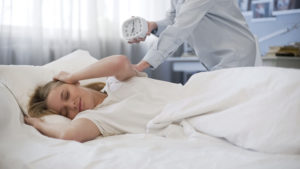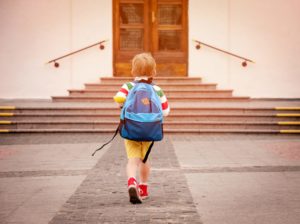Screen Time and Insomnia: What It Means for Teens
The majority of teenagers bring some kind of technology into the bedroom, adding to the amount of screen time they get each day and affecting multiple areas of their lives. Experts are becoming increasingly concerned about the effects of blue light from these electronic devices on the sleep-wake cycle. An estimated 2 in 3 teenagers regularly sleep less than the recommended amount, and screen time may be responsible for sleep deprivation and other problems.
How Do Screens Affect the Sleep-Wake Cycle?
The human sleep-wake cycle is a circadian rhythm that mostly takes cues from sunlight. When it is bright outside, people become more alert. When it becomes dark, the body produces a hormone called melatonin that induces sleepiness.
Smartphones, tablets, computers, television screens, and some e-readers give off short-wavelength blue light that is very similar to sunlight. Not only does this light make people more alert, it also deceives the body into thinking it is still daytime.
In response, the body produces less melatonin, interfering with the body’s natural sleep-wake cycle. The longer you spend on your screen, the greater the consequences for your sleep.
Does Screen Time Cause Insomnia in Teenagers?
Screen time is linked to a host of insomnia symptoms in teenagers. By delaying the release of melatonin, screen time lengthens the time it takes to fall asleep and leads to less restful sleep overall. As the majority of teens have strict school start times, a later bedtime typically results in fragmented sleep and increased next-day sleepiness. Over time, consistently late weekday bedtimes and catch-up sleep on the weekend disrupt the circadian rhythm.
Scientists believe that children and adolescents may be extra sensitive to the effects of blue light because their eyes let more light in . For this reason, limiting evening screen time for children and adolescents is especially important to prevent sleep problems.
In addition to suppressing melatonin levels, screen time for teens may directly reduce sleep time. Engaging in exciting content before bedtime or using social media can boost alertness and impede sleepiness. Alertness and melatonin levels can also be affected by passive technology, such as a television running in the background or a smartphone that emits sounds, vibrations, and light.
There is some debate about if screen time actually causes insomnia in teens, or if teens who have trouble sleeping are more likely to use screens at night. To make matters more complicated, excessive mobile phone use has been linked to symptoms of depression and anxiety , which are additional risk factors for insomnia. It may be that sleep, screen time, and negative emotions interact to exacerbate unhealthy behaviors.
The prevailing opinion among health experts is that screen time has a greater effect on insomnia than vice-versa. Studies show that 57% of teens who use technology in the bedroom suffer from sleep problems, and teens consistently report worse sleep when they have a television or small screen , such as a smartphone, in the bedroom.
Which Devices Have the Biggest Impact on Sleep Quality?
Researchers are not sure whether or not certain devices are worse than others when it comes to sleep problems. Computers, tablets, smartphones, televisions, and game consoles have all been shown to impact sleep, especially when used in the hour before bedtime.
Some experts believe that sleep is hindered more with devices that require interactive use, such as a smartphone or a video game console. Others suggest that smartphones might impact melatonin levels more than television screens since they tend to be held nearer to the face. Along the same lines, sleep appears to suffer more when teenagers use screens in a dark room , possibly because their pupils are more dilated and let more blue light pass through.
The more time a teenager spends on a screen each day, the more likely they are to have disturbed sleep . Also, using a phone to communicate with others near bedtime could lead to less sleep as teens stay up later to wait for a reply. Finally, keeping a phone unsilenced overnight is also shown to disturb sleep, as alerts for incoming messages may wake teens.
Consequences of Sleep Deprivation for Teens
Sleep deprivation during adolescence can cause problems with mood, emotion, and academic performance. Teens experiencing fragmented sleep are more likely to have interpersonal issues with their peers, and chronic sleep loss can lead to a weakened immune system and some mental health conditions. Sleep loss also leads to increased tiredness during the day, which can be very dangerous for young drivers.

Tips for Adolescent Screen Time and Sleep
Because teenagers need to use screens for academic and social obligations, medical professionals prefer not to put an exact number on the recommended screen time for teens. Instead, they urge parents to develop a personalized family media protocol.
A family media protocol should include clear limits on screen time, and allot time for healthy activities such as sleep, family time, schoolwork, and exercise. Teens do best when they are given the chance to participate in creating their own guidelines, so consider sitting down together and making a plan for screen time. There are several sleep-promoting strategies which can improve your teenager’s screen use habits and sleeping environment.
- Set boundaries for screen time: Agree on a “screen curfew” and encourage your teen to reduce screen use earlier in the day when possible. Decide where to charge smartphones, ideally outside of the teen’s bedroom.
- Choose an age-appropriate bedtime: Keep in mind that teens need 8 to 10 hours of sleep , and choose bed and wake-up times that allow for sufficient sleep.
- Practice good sleep hygiene: Keep your teen’s bedroom cool, dark, and quiet. Dim screens, choose night modes, and switch to warm household lighting in the lead-up to bedtime.
- Support mental wellness: Create a calming bedtime routine to replace screen use, including activities such as reading or chatting. Listen to your teen’s worries, such as the fear they might be missing out on social updates, and find ways to work solutions into the media plan.
- Get educated: Discuss the consequences of sleep deprivation and remind your teen that less screen time gives them more time for socializing, family time, homework, sports, and extracurricular activities.
Ideally, the bedroom should be a screen-free zone. Reserving the bedroom for sleep helps the brain wind down and associate the space with sleep. However, it is not always feasible to keep technology out of the bedroom. If your teen must use technology in the bedroom, ask them to turn their devices off about an hour before bedtime. Glasses or applications designed to filter out blue light also appear to minimize disruptions to teenagers’ sleep.
To help teenagers adopt healthy screen habits, parents and caregivers should strive to be positive role models by limiting their own screen use.

Still have questions? Ask our community!
Join our Sleep Care Community — a trusted hub of sleep health professionals, product specialists, and people just like you. Whether you need expert sleep advice for your insomnia or you’re searching for the perfect mattress, we’ve got you covered. Get personalized guidance from the experts who know sleep best.
References
11 Sources
-
Hysing, M., Pallese, S., Stormark, K., Jakobsen, R., Lundervold, A. J., & Sivertsen, B. (2015). Sleep and use of electronic devices in adolescence: Results from a large population-based study. BMJ Open, 5(1), e006748.
https://pubmed.ncbi.nlm.nih.gov/25643702/ -
Turner, P. L., & Mainster, M. A. (2008). Circadian photoreception: Aging and the eye’s important role in systemic health. The British Journal of Ophthalmology, 92(11), 1439–1444.
https://pubmed.ncbi.nlm.nih.gov/18757473/ -
Scott, H., Biello, S. M., & Woods, H. C. (2019). Social media use and adolescent sleep patterns: Cross-sectional findings from the UK millennium cohort study. BMJ Open, 9(9), e031161.
https://pubmed.ncbi.nlm.nih.gov/31641035/ -
Liu, S., Wing, Y. K., Hao, Y., Li, W., Zhang, J., & Zhang, B. (2019). The associations of long-time mobile phone use with sleep disturbances and mental distress in technical college students: A prospective cohort study. Sleep, 42(2), 10.1093/sleep/zsy213.
https://pubmed.ncbi.nlm.nih.gov/30395300/ -
Hale, L., Kirschen, G. W., LeBourgeois, M. K., Gradisar, M., Garrison, M. M., Montgomery-Downs, H., Kirschen, H., McHale, S. M., Chang, A. M., Buxton, O. M. (2018). Youth screen media habits and sleep: Sleep-friendly screen behavior recommendations for clinicians, educators, and parents. Child and Adolescent Psychiatric Clinics of North America. 27(2), 229-245.
https://pubmed.ncbi.nlm.nih.gov/29502749/ -
Falbe, J., Davison, K. K., Franckle, R. L., Ganter, C., Gortmaker, S. L., Smith, L., Land, T., & Taveras, E. M. (2015). Sleep duration, restfulness, and screens in the sleep environment. Pediatrics, 135(2), e367–e375.
https://pubmed.ncbi.nlm.nih.gov/25560435/ -
Hale, L., & Guan, S. (2015). Screen time and sleep among school-aged children and adolescents: A systematic literature review. Sleep Medicine Reviews, 21, 50–58.
https://pubmed.ncbi.nlm.nih.gov/25193149/ -
Mireku, M. O., Barker, M. M., Mutz, J., Dumontheil, I., Thomas, M., Röösli, M., Elliott, P., & Toledano, M. B. (2019). Night-time screen-based media device use and adolescents’ sleep and health-related quality of life. Environment International, 124, 66–78.
https://pubmed.ncbi.nlm.nih.gov/30640131/ -
Foerster, M., Henneke, A., Chetty-Mhlanga, S., & Röösli, M. (2019). Impact of adolescents’ screen time and nocturnal mobile phone-related awakenings on sleep and general health symptoms: A prospective cohort study. International Journal of Environmental Research and Public Health, 16(3), 518.
https://www.ncbi.nlm.nih.gov/pmc/articles/PMC6388165/ -
Paruthi, S., Brooks, L. J., D’Ambrosio, C., Hall, W. A., Kotagal, S., Lloyd, R. M., Malow, B. A., Maski, K., Nichols, C., Quan, S. F., Rosen, C. L., Troester, M. M., & Wise, M. S. (2016). Consensus statement of the American Academy of Sleep Medicine on the recommended amount of sleep for healthy children: Methodology and discussion. Journal of Clinical Sleep Medicine, 12(11), 1549–1561.
https://pubmed.ncbi.nlm.nih.gov/27707447/ -
Van der Lely, S., Frey, S., Garbazza, C., Wirz-Justice, A., Jenni, O. G., Steiner, R., Wolf, S., Cajochen, C., Bromundt, V., & Schmidt, C. (2015). Blue blocker glasses as a countermeasure for alerting effects of evening light-emitting diode screen exposure in male teenagers. The Journal of Adolescent Health, 56(1), 113–119.
https://pubmed.ncbi.nlm.nih.gov/25287985/





